|
|
 Vintage Mayapur
Vintage Mayapur Here’s a few photos from the Bhaktivedanta Archives of Mayapur circa 1972-1980. It serves to remind us that Mayapur has been a continuous development and will continue to be so. Just as rice paddies were turned in to parks and fountains, now the parks and fountains are making way for something new–the Temple of the Vedic Planetarium.
Here’s how it all began:

International Headquarters 1971

During a flood 1979
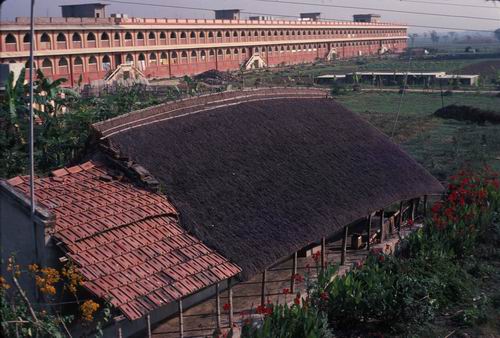
Circa 1980
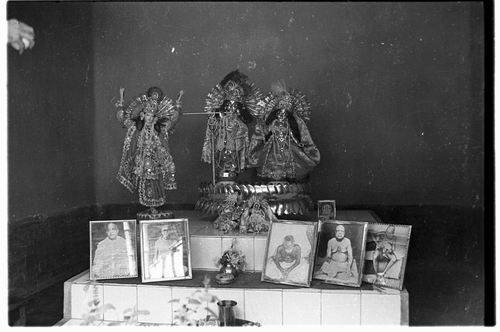
Eternal Residents of Mayapur, Sri Sri Radha Madhava and Sri Caitanya-1971
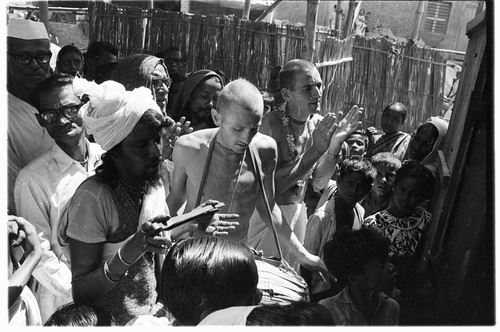
and Their eternal servants

the transcendental twins about whom Srila Prabhupada said "These twins, everyone should know it, there is no comparison."

Their Lordships and Their intimate servants--1979

Sri Sri Radha Madhava 1979

from the Lotus building to the main gate 1976

1980

1980 - Lotus building

Gurukula boys 1980

So what are you waiting for? Come and visit Mayapur...
 All Things Must Pass… Gone-vindas and the late Lotus
All Things Must Pass… Gone-vindas and the late Lotus Great news from Mayapur. Here’s a few photos I took today. As you can see, some major changes are taking place. The park is being cleared in preparation for the ground work to begin on the Temple of the Vedic Planetarium (TOVP).
There is a good deal of nostalgia for the park, the famous Lotus Fountain, the lawns and trees and flowers. Literally tens of millions of visitors (four million just during last year) have enjoyed the peaceful environs of the ISKCON Mayapur Candrodaya Mandir gardens and they have served us well. Still I can’t help but be elated in seeing the acceleration of the demolition as preparations gear up.
By January we hope to see the pile drivers in place and work on the foundations begin in earnest. In early February the entire GBC body will attend an inaugural ceremony to create an auspicious beginning for the works. If you are coming for Gaura Purnima, be prepared for some major changes!

The park area circa 1976

Lotus Fountain -- the beginning (circa 1980)

Lotus Fountain -- the beginning
And the end... November 2009
After nearly 30 years of service, the Lotus Fountain goes under the hammers
30 years and millions of visitors later, the Lotus Fountain bids adieu
All things must pass
Here’s the new perimeter demarking the boundary of the TOVP. These poles will be adorned with tin sheets and the whole area will be off limits to visitors while the construction goes on.
TOVP perimeter fence poles go in
Take a last look, by Gaura Purnima this will be a solid fence
One place I was particularly glad to see dismantled was this:
Govinda's dhaba bites the dust
Going, going, ...
Gone-vindas
A new first class restaurant is under construction and will be operational within two months. It will comprise of three areas-Bengali cuisine, Indian cuisine, and an air conditioned full service Italian restaurant. Another area will be for snacks and take-aways so that sit down diners will not be disturbed. There will be three kitchens with different crews cooking for each one.
 Q&As: Was Srila Prabhupada conditioned? [part two]
Q&As: Was Srila Prabhupada conditioned? [part two] Here’s the second part of the question regarding Srila Prabhupada’s alleged projection of personal sexual frustration into his presentation of Krsna consciousness:
Question:
Here is the phrase in question, corresponding to SB 10.58.17-19. The troublesome words are two, “raised breasts” [which are not in the original Sanskrit]. We would be very much pleased to hear your expert opinion in regard to this matter.
Quote from Krsna book, chapter 58: “Five Queens Married by Krsna”
“While resting and drinking water, they saw a beautiful girl of marriageable age walking alone on the bank of the Yamuna. Krsna asked His friend Arjuna to go forward and ask the girl who she was. By the order of Krsna, Arjuna immediately approached the girl, who was very beautiful. She had an attractive body, nice, glittering teeth and a smiling face. Arjuna inquired, “My dear girl, you are so beautiful with your raised breasts. May I ask you who you are? We are surprised to see you loitering here alone. What is your purpose in coming here? We can guess only that you are searching after a suitable husband. If you don’t mind, you can disclose your purpose. I shall try to satisfy you.”
Answer:
This reply is a little lengthy but it is necessary in order to establish the proper perspective on this question. This is a serious issue and I humbly request you to please give this a serious read.
In giving this description in his summary study ‘Krsna’ Srila Prabhupada is simply following the lead of Srila Vyasadeva, the author of the Srimad Bhagavatam.
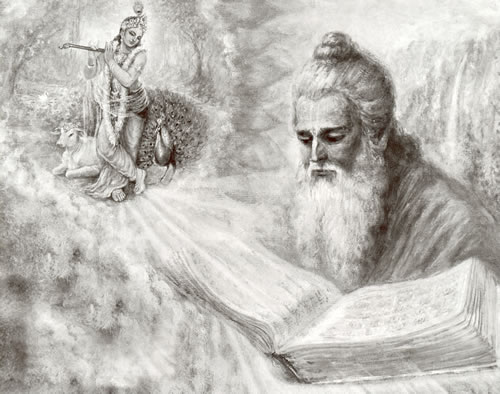
In the SB there are many places where the beauty of a woman includes a description of her breasts. They are mentioned specifically as being “raised” “projecting upwards” etc. I will give some examples of this later in this text.
What to speak of material women, there are specific descriptions of Krsna’s queens, or the Gopis intimately playing with Krsna, which also mention that a component of their spiritual beauty is their attractive breasts, which are sometimes compared to cakravaka birds.
Consequently, when Srila Prabhupada includes the phrase “raised breasts” in his summary study of the 10th Canto description of the meeting between Krishna, Arjuna and Kalindi, Srila Prabhupada’s addition of this phrase is not at all material, nor is it a product of his lust, frustration, attraction to the forms of material women etc. It is a factual parampara expression of the transcendental beauty of one of Lord Krsna’s eternal and most intimate devotees, His wife Kalindi. Even though it is not directly in the text, it is still a fact and Srila Prabhupada’s addition of it is perfectly spiritual.
Kalindi is part of the internal energy of the Lord. She is a direct expansion of Radharani.

She is the Yamuna personified and one of the eight principle queens of Lord Krishna. As such there is no material aspect to her beauty. As Srila Prabhupada writes in the SB 1st Canto:
SB 1.11.31
“Unbelievers become astonished to learn that Lord Krsna married more than 16,000 queens because they think of Lord Krsna as one of them and measure the potency of the Lord by their own limited potency. One should know, therefore, that the Lord is never on the level of the living beings, who are but expansions of His marginal potency, and one should never equalize the potent and the potency, although there is very little difference of quality between the potent and the potency. The queens were also expansions of His internal potency, and thus the potent and potencies are perpetually exchanging transcendental pleasures, known as pastimes of the Lord.”
And again, according to Srila Visvanatha Cakravarti Thakura,

as quoted by Hridayananda Maharaja in his purport of SB 10.83.40:
“In the opinion of Srila Visvanatha Cakravarti, Srimati Laksmana became embarrassed when she realized that she had been talking about herself, and so she spoke this verse praising her co-wives. In her humility Laksmana claimed that Krsna’s queens, unlike ordinary wives, could not bring their husband under control, and thus they could relate to Him only as servile housekeepers. In fact, however, since the Lord’s queens are direct expansions of His internal pleasure potency (hladini-sakti), they fully controlled Him with their love.”
Srila Jiva Goswami in his Krsna-sandarbha, describes the queens of Krsna as expansions of His internal potency, and Srila Sukadeva Goswami, at the end of his narration of Narada Muni’s visits to the palaces of the queens of Dvaraka, says,
“Lord Hari is the ultimate cause of universal creation, maintenance and destruction. My dear King, anyone who chants about, hears about or simply appreciates the extraordinary activities He performed in this world, which are impossible to imitate, will surely develop devotion for the Supreme Lord, the bestower of liberation.”
Srila Prabhupada summarizes this verse in the Krsna book by saying:
“In narrating the activities of Lord Krsna in Dvaraka, Sukadeva Gosvami explained to King Pariksit how Lord Krsna, the Supreme Personality of Godhead, descends to this material universe by the agency of His internal potency and personally exhibits the principles which, if followed, can lead one to achieve the ultimate goal of life. All the queens in Dvaraka, more than sixteen thousand in number, engaged their feminine attractive features in the transcendental service of the Lord by smiling and serving, and the Lord was pleased to behave with them exactly like a perfect husband enjoying household life. One should know definitely that such pastimes cannot be performed by anyone but Lord Sri Krsna, who is the original cause of the creation, maintenance and dissolution of the whole cosmic manifestation. Anyone who attentively hears the narrations of the Lord’s pastimes in Dvaraka or supports a preacher of the Krsna consciousness movement will certainly find it very easy to traverse the path of liberation and taste the nectar of the lotus feet of Lord Krsna. And thus he will be engaged in Lord Krsna’s devotional service.”
Therefore if Srila Prabhupada, as a pure devotee, includes an additional description of Kalindi’s beauty, there is no wrong in that, it is rather an aspect of his service and glorification of the Lord and His internal devotees. It is meant to show us that the great devotees of the Lord please Him by their personal beauty and service attitude which is all offered for His pleasure.
Now I shall give some examples where Srila Vyasadeva has included in the SB some descriptions of the breasts of women. In reading this you can just reflect on whether Vyasadeva was doing this because of his own frustrated sex life, or because there is some transcendental purpose.
 Q&As: Was Srila Prabhupada conditioned? [part one]
Q&As: Was Srila Prabhupada conditioned? [part one] From time to time I hear comments or get asked questions which imply that Srila Prabhupada was affected by his apparently material circumstances that existed before his becoming the Founder Acarya of ISKCON.
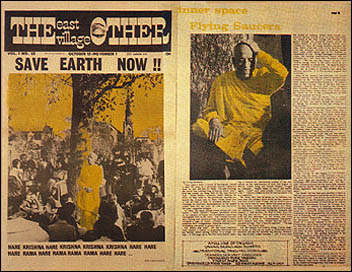
As it goes, the accusation states that Srila Prabhupada’s presentation of Krsna consciousness, its practice, was tainted by his personal failures or by his upbringing in early 20th century Bengal. One such critique centers on his explanations of the intelligence of women; another on his insistence of the four regulative principles; another on his comments about the moon. And the list goes on.
It is to be expected because this is Kali Yuga and people cannot easily escape their conditioning and see things from the transcendental perspective. The tendency is to modify transcendental teachings to fit within their own conditioned frameworks.
ISKCON is going the same way all pure spiritual movements go in Kali-yuga. It is being materialized by people who don’t have the ability or desire to transform themselves or be transformed, and instead transform Krsna consciousness to their mundane convenience.
As George Bernard Shaw once wrote:

“The great danger of conversion in all ages has been that when the religion of the high mind is offered to the lower mind, the lower mind, feeling its fascination without understanding it, and being incapable of rising to it, drags it down to its level by degrading it.”
Even though this trend is to be expected, I was still surprised to hear this latest criticism of His Divine Grace, sent to me for comment by one of our Mayapur devotees:
 Hallowed be Thy Name…
Hallowed be Thy Name… I just saw a blog by Vineet Chander called ‘OmSweetOm’. It was all about a new Halloween costume based on the Hare Krishna look: http://blog.beliefnet.com/omsweetom/2009/11/a-hare-krishna-halloween.html#preview

Hallowing the Holy Name
Inevitably there are calls to protest this ‘insult’ to Krishna consciousness and Hinduism. Vineet gives a reasonable perspective on why he thinks we should not, but he misses the real point.
According to the Caitanya Caritamrta if a person somehow chants the holy names, even in joking, they get transcendental benefit:
Adi 17.200
sei haite jihva mora bale ‘hari’ ‘hari’
iccha nahi, tabu bale, — ki upaya kari
TRANSLATION
“‘Since that time, my tongue also always vibrates the sound “Hari, Hari.” I have no desire to say it, but still my tongue says it. I do not know what to do.’
PURPORT
Sometimes demoniac nonbelievers, not understanding the potency of the holy name, make fun of the Vaisnavas when the Vaisnavas chant the Hare Krsna maha-mantra. This joking is also beneficial for such persons. Srimad-Bhagavatam, Sixth Canto, Second Chapter, verse 14, indicates that the chanting of the Hare Krsna maha-mantra, even in joking, in the course of ordinary discussion, in indicating something extraneous, or in negligence, is called namabhasa, which is chanting that is almost on the transcendental stage. This namabhasa stage is better than namaparadha. Namabhasa awakens the supreme remembrance of Lord Visnu. When one remembers Lord Visnu, he becomes free from material enjoyment. Thus he gradually comes forward toward the transcendental service of the Lord and becomes eligible to chant the holy name of the Lord in the transcendental position.”
Vineet’s article got it right, although he didn’t fully explain why the ‘halloween Haris” is Ok. Srila Prabhupada gives the explanation above. To chant Hare Krishna is better than to not chant Hare Krishna, even if it is done in jest, which the Halloweeners most certainly do. They are chanting Hare Krishna throughout the Halloween festival which they may never have done otherwise.
Think about it–they spend at least a few hours imitating a Hare Krishna devotee. Now think about another great imitator and the result she got…
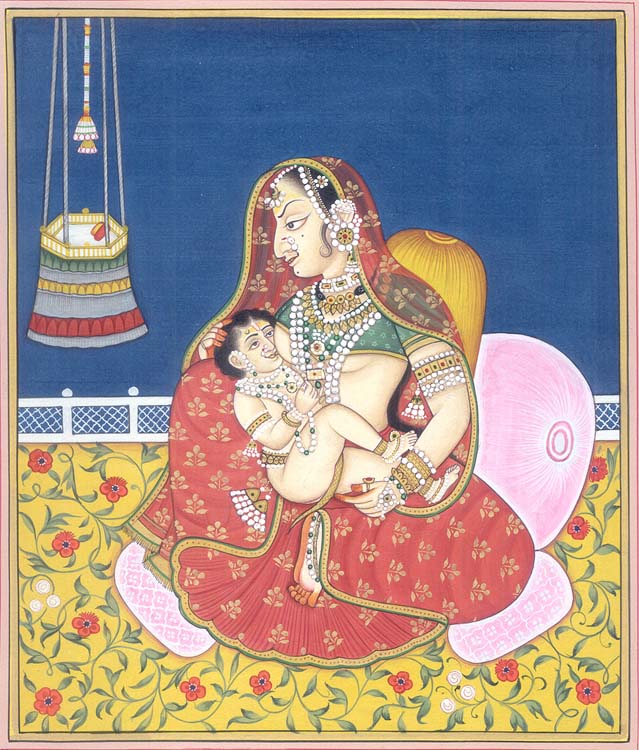
Srila Prabhupada was always pleased to see Krishna’s names chanted, even in apparently adverse circumstances. It reminds me of when I was with him in Calcutta on February 5th 1977. An article had come out in a Boston newspaper asking whether the Hare Krishna devotees were good or bad:
[Note: excerpted directly from my original diary. This has not yet edited or been published]
